
(a)
Interpretation:
The synthesis of
Concept introduction:
Oxymercuration reaction is a type of reaction in which an
Answer to Problem 11.61AP
The synthesis of

Explanation of Solution
The mercuric acetate

Figure 1
The route of synthesis of the formation of
(b)
Interpretation:
The synthesis of
Concept introduction:
The substances which on addition removes oxygen atom or hydrogen atom from the other substance, that is, reduces the other substances are known as reducing agents. Reducing agents themselves get oxidized. Strong reducing agents like
Answer to Problem 11.61AP
The synthesis of
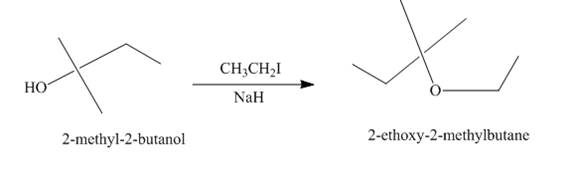
Explanation of Solution
The treatment of
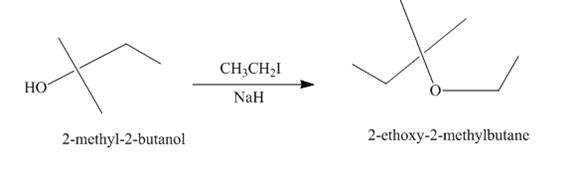
Figure 2
The route of synthesis of the formation of
(c)
Interpretation:
The synthesis of
Concept introduction:
Grignard reagents are
Answer to Problem 11.61AP
The synthesis of

Explanation of Solution
The reaction of tert-butyl bromide with

Figure 3
The route of synthesis of the formation of
(d)
Interpretation:
The synthesis of the given compound from the compounds that contain
Concept introduction:
Oxidation is the process in which there is an addition of oxygen atom or removal of hydrogen atom. The agents used for the oxidation reaction is known as oxidizing agents. It oxidizes the other substance and gets reduced in the reaction. The common oxidizing agents are nitric acid, oxygen and potassium dichromate.
Answer to Problem 11.61AP
The synthesis of the given compound from the compounds that contain
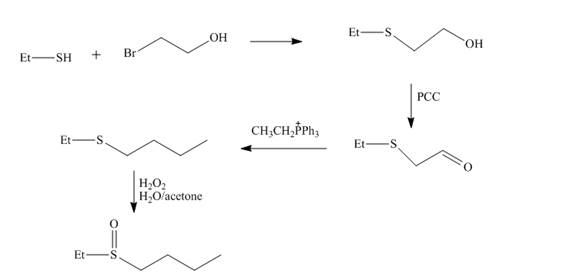
Explanation of Solution
The reaction of ethnethiol with
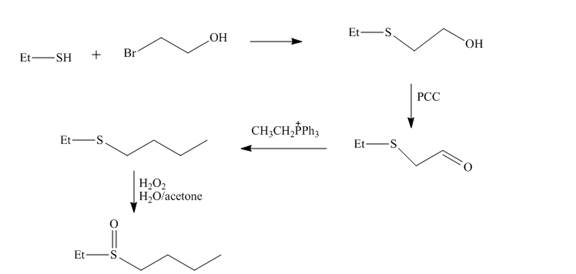
Figure 4
The synthesis of the given compound from the compounds that contain
(e)
Interpretation:
The synthesis of the given compound from an alkene is to be drawn.
Concept introduction:
Oxidation is the process in which there is an addition of oxygen atom or removal of hydrogen atom. The agents used for the oxidation reaction is known as oxidizing agents. It oxidizes the other substance and gets reduced in the reaction. The common oxidizing agents are nitric acid, oxygen and potassium dichromate.
Answer to Problem 11.61AP
The synthesis of the given compound from an alkene is shown below.
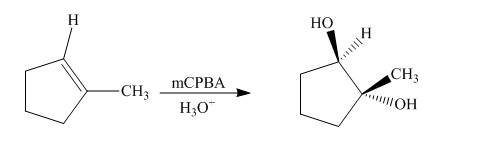
Explanation of Solution
The reaction of

Figure 5
The synthesis of the given compound from an alkene is shown in Figure 5.
(f)
Interpretation:
The synthesis of cyclohexyl isopropyl ether from cyclohexene is to be drawn.
Concept introduction:
Oxidation is the process in which there is an addition of oxygen atom or removal of hydrogen atom. The agents used for the oxidation reaction is known as oxidizing agents. It oxidizes the other substance and gets reduced in the reaction. The common oxidizing agents are nitric acid, oxygen and potassium dichromate.
Answer to Problem 11.61AP
The synthesis of cyclohexyl isopropyl ether from cyclohexene is shown below.
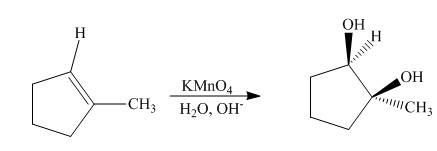
Explanation of Solution
The compound,

Figure 6
The synthesis of cyclohexyl isopropyl ether from cyclohexene is shown Figure 6.
(g)
Interpretation:
The synthesis of cyclohexyl isopropyl ether from cyclohexene is to be drawn.
Concept introduction:
Oxymercuration reaction is a type of reaction in which an alkene gets converted to alcohol. The mercuric acetate is used in the reaction as a reagent. This reagent attacks the alkene to form a cyclic intermediate compound which further undergoes reduction to form alcohol.
Answer to Problem 11.61AP
The synthesis of cyclohexyl isopropyl ether from cyclohexene is shown below.

Explanation of Solution
The mercuric acetate

Figure 7
The synthesis route of cyclohexyl isopropyl ether from cyclohexene is shown in Figure 7.
(h)
Interpretation:
The synthesis of the given compound from
Concept introduction:
Grignard reagents are organometallic compounds which are prepared using alkyl halides in the presence of magnesium metal in dry ether. These reagents act as strong nucleophiles and bases
Answer to Problem 11.61AP
The synthesis of the given compound from
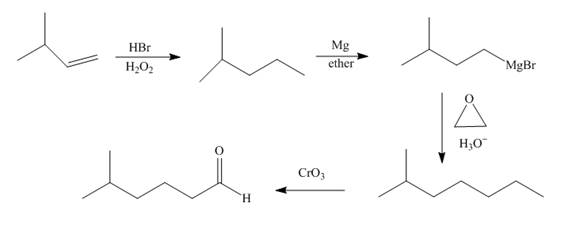
Explanation of Solution
Bromination of alkene occurs with
Grigmard reagent reacts with the ethylene oxide followed by the hydrolysis to form an alcohol which upon oxidation by
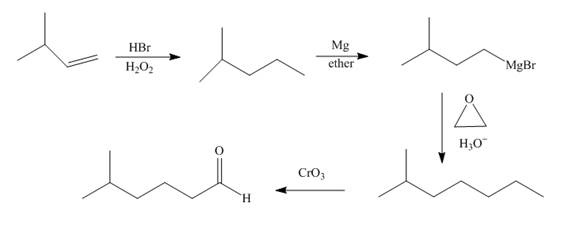
Figure 8
The synthesis of the given compound from
(i)
Interpretation:
The synthesis of the given compound from
Concept introduction:
An
Oxidation is the process in which there is an addition of oxygen atom or removal of hydrogen atom. The agents used for the oxidation reaction is known as oxidizing agents. It oxidizes the other substance and gets reduced in the reaction. The common oxidizing agents are nitric acid, oxygen and potassium dichromate.
Answer to Problem 11.61AP
The synthesis of the given compound from
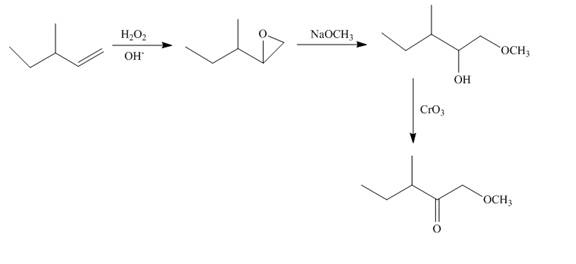
Explanation of Solution
Epoxidation of

Figure 9
The synthesis route of the given compound from
(j)
Interpretation:
The synthesis of the given compound from
Concept introduction:
An epoxide is cyclic ether. It can be prepare by the reaction of alkene with percarboxylic acid with removal of carboxylic acid. An epoxide undergoes ring opening reactions with an acid to give a product with inversion configuration.
Oxidation is the process in which there is an addition of oxygen atom or removal of hydrogen atom. The agents used for the oxidation reaction is known as oxidizing agents. It oxidizes the other substance and get reduced in the reaction. The common oxidizing agents are nitric acid, oxygen and potassium dichromate.
Answer to Problem 11.61AP
The synthesis of the given compound from

Explanation of Solution
Epoxidation of

Figure 10
The synthesis route of the given compound from
(k)
Interpretation:
The synthesis of given compound from the allyl chloride is to be drawn.
Concept introduction:
The nucleophilic substitution reactions depend upon the nucleophilicity and concentration of the nucleophile. There are two types of nucleophilic substitution reaction.
The
Answer to Problem 11.61AP
The synthesis of given compound from the allyl chloride is shown below.

Explanation of Solution
Allyl chloride reacts with

Figure 11
The synthesis of given compound from the allyl chloride is shown in Figure 11.
(l)
Interpretation:
The synthesis of the given compound is to be drawn.
Concept introduction:
Wolff Kishner Reduction is a reaction in which aldehydes and
Answer to Problem 11.61AP
The synthesis of the given compound is shown below.
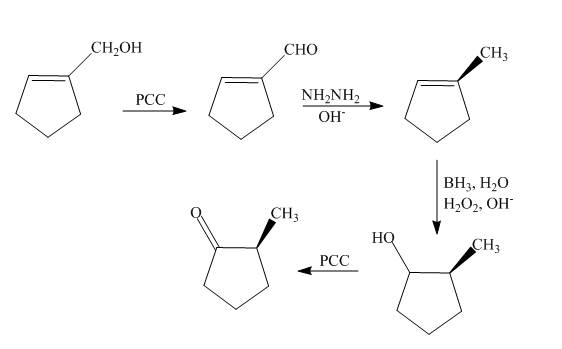
Explanation of Solution
The reaction of cyclopentenyl methanol with

Figure 12
The synthesis of the given compound is shown in Figure 12.
(m)
Interpretation:
The synthesis of the given compound is to be drawn.
Concept introduction:
The substances which on addition removes oxygen atom or hydrogen atom from the other substance, that is, reduces the other substances are known as reducing agents. Reducing agents themselves get oxidized. Strong reducing agents like
Answer to Problem 11.61AP
The synthesis of the given compound is shown below.

Explanation of Solution
The alcohol is reduced in presence of

Figure 13
The synthesis of the given compound is shown in Figure 13.
Want to see more full solutions like this?
Chapter 11 Solutions
Organic Chemistry, Ebook And Single-course Homework Access
- Write the systematic name of each organic molecule: structure HO-C-CH2-CH3 O -OH CH3-CH2-CH2-CH2-CH2-C-OH CH3 CH3-CH-CH2-C-OH Explanation Check S namearrow_forwardtheres 2 productsarrow_forwardDraw the major product of this solvolysis reaction. Ignore any inorganic byproducts. + CH3CH2OH Drawing Q Atoms, Bonds and Rings OCH2CH3 || OEt Charges OH 00-> | Undo Reset | Br Remove Done Drag To Pan +arrow_forward
- Draw the major product of this SN1 reaction. Ignore any inorganic byproducts. CH3CO2Na CH3CO2H Drawing + Br Q Atoms, Bonds and Rings OAC Charges OH ОАс Na ဂ Br Undo Reset Remove Done Drag To Pan +arrow_forwardOrganic Functional Groups entifying positions labeled with Greek letters in acids and derivatives 1/5 ssible, replace an H atom on the a carbon of the molecule in the drawing area with a ce an H atom on the ẞ carbon with a hydroxyl group substituent. ne of the substituents can't be added for any reason, just don't add it. If neither substi er the drawing area. O H OH Oneither substituent can be added. Check D 1 Accessibility ado na witharrow_forwardDifferentiate between electrophilic and nucleophilic groups. Give examples.arrow_forward
- An aldehyde/ketone plus an alcohol gives a hemiacetal, and an excess of alcohol gives an acetal. The reaction is an equilibrium; in aldehydes, it's shifted to the right and in ketones, to the left. Explain.arrow_forwardDraw a Haworth projection or a common cyclic form of this monosaccharide: H- -OH H- OH H- -OH CH₂OHarrow_forwardAnswer the question in the first photoarrow_forward
- Ggggffg2258555426855 please don't use AI Calculate the positions at which the probability of a particle in a one-dimensional box is maximum if the particle is in the fifth energy level and in the eighth energy level.arrow_forwardExplain the concepts of hemiacetal and acetal.arrow_forwardBriefly describe a nucleophilic addition.arrow_forward
 ChemistryChemistryISBN:9781305957404Author:Steven S. Zumdahl, Susan A. Zumdahl, Donald J. DeCostePublisher:Cengage Learning
ChemistryChemistryISBN:9781305957404Author:Steven S. Zumdahl, Susan A. Zumdahl, Donald J. DeCostePublisher:Cengage Learning ChemistryChemistryISBN:9781259911156Author:Raymond Chang Dr., Jason Overby ProfessorPublisher:McGraw-Hill Education
ChemistryChemistryISBN:9781259911156Author:Raymond Chang Dr., Jason Overby ProfessorPublisher:McGraw-Hill Education Principles of Instrumental AnalysisChemistryISBN:9781305577213Author:Douglas A. Skoog, F. James Holler, Stanley R. CrouchPublisher:Cengage Learning
Principles of Instrumental AnalysisChemistryISBN:9781305577213Author:Douglas A. Skoog, F. James Holler, Stanley R. CrouchPublisher:Cengage Learning Organic ChemistryChemistryISBN:9780078021558Author:Janice Gorzynski Smith Dr.Publisher:McGraw-Hill Education
Organic ChemistryChemistryISBN:9780078021558Author:Janice Gorzynski Smith Dr.Publisher:McGraw-Hill Education Chemistry: Principles and ReactionsChemistryISBN:9781305079373Author:William L. Masterton, Cecile N. HurleyPublisher:Cengage Learning
Chemistry: Principles and ReactionsChemistryISBN:9781305079373Author:William L. Masterton, Cecile N. HurleyPublisher:Cengage Learning Elementary Principles of Chemical Processes, Bind...ChemistryISBN:9781118431221Author:Richard M. Felder, Ronald W. Rousseau, Lisa G. BullardPublisher:WILEY
Elementary Principles of Chemical Processes, Bind...ChemistryISBN:9781118431221Author:Richard M. Felder, Ronald W. Rousseau, Lisa G. BullardPublisher:WILEY





